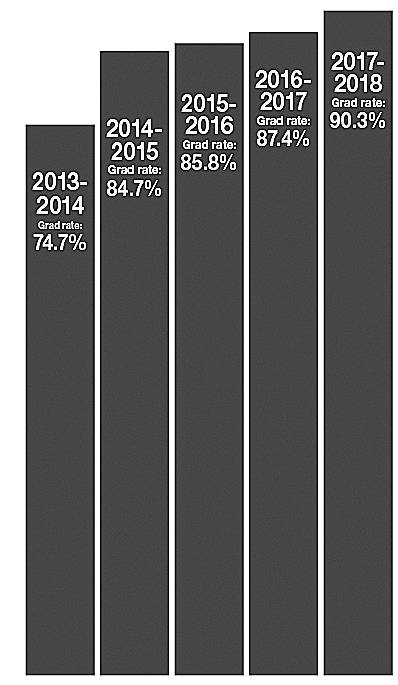Sequim High School recently graduated its first class after the full adoption for Washington’s Core 24 graduation requirement program — and while graduation rates had been on the rise, some concerns about the program are looming as well, especially after SHS’s graduation rate fell slightly in 2019.
Searching for a way to boost not only the state’s graduation rates but also to better prepare high school students for what comes next — be that college or a trade — the Washington State Board of Education created Core 24 as a new set of graduation requirements to accomplish that goal.
Core 24 increases state-mandated credits requirement for graduation from 20 to 24 as well as increasing the requirements in terms of core class requirements and state assessment tests.
The increased requirements leave little room for error — i.e. failing a class or classes — for students trying to work their way through high school, local educators note.
Speaking to the Sequim Gazette several weeks before graduation, Sequim School District Superintendent Gary Neal said he hasn’t seen much benefit to that added pressure on students.
“With a six-period schedule,” Neal said, “and each class being worth half a credit, at the end of the school year that’s six credits of the 24. If a student doesn’t pass one class, they’re half a credit behind right off the bat, and the system keeps moving on.”
Neal said he fears graduation rates could drop again because of that pressure and lack of room for error, and that played out in 2019, falling from a 90.3 percent graduation rate in 2018 to 85.2 percent this year, with 185 out of 217 seniors graduating.
According to statistics presented by high school staff to the Sequim school board on May 6, Sequim High School has 57 freshmen considered “off-track” for graduation after failing one or more classes in their first semester of high school.
That same document lists three tiers of programs aimed at helping underclassmen who have fallen behind, ranging from afterschool support programs to summer school to using an Individualized Education Program that helps structure current special education programs in Washington state.
The document also notes, however, that falling full-time equivalency rates — a measure of staffing levels based on student attendance of classes and programs — in some program areas of the high school means that there will be less counseling and support resources for those struggling students, giving them less ability to make up any lost ground.
Sequim Options School, another resource used by seniors who need to make up missing credits before graduation, highlighted efforts of several students who are on track to graduate now after being well behind at the start of the school year at a May 20 school board meeting. That presentation noted SOS staff worked with 87 seniors this school year, compared to 43 students in the 2017-2018 school year — and a number representing 40 percent of the 2019 senior class.
Sequim Options School is impacted by cuts to staffing levels, with one-third of the 1.2 staffing number slated to be cut in the 2019-20 budget, according to their presentation.
Neal said he views SOS not as an alternative school but as “a necessary option to have available for a student body that’s diverse in how it needs to learn.”
Neal said, “Even if we have to get creative with funding, we need to make sure (SOS) can help as many students as possible.”
The demands of Core 24, Neal said, “make it hard to receive a well-rounded education” because of the lack of time in the day available for elective classes — particularly if a student has to make up core English, math or science classes that are emphasized under the Core 24 program.
Programs such as fine arts, performing arts, music and physical education classes have lower attendances, Neal said — meaning their own staffing levels will fall as well.
Neal suggested that instead of the “unfunded mandate dropped on schools’ laps” that Core 24 represented — one that he said was not supported by the associations of state superintendents, principals or teachers when it was implemented — and forcing students to take more of the same classes that are already struggling with, it would be better to overhaul “an education system that hasn’t changed in more than 100 years” to include more diverse and well-rounded learning opportunities, to help account for students of different needs.
Neal is leaving the Sequim School District when his contract expires shortly after the school year ends in June, but he said he hopes his successor can find a way to make Core 24 fit better with Sequim’s needs.
He listed various solutions, including going to a seven-class system to allow for more class options and elective time for students.
Neal said he’s proud of this year’s graduating class of Sequim High School and staff members who worked with them.
“These students and their teachers have overcome numerous challenges over the last four years,” Neal said, “but they’ve done wonderfully in doing so, and their work deserves to be recognized and praised.”



